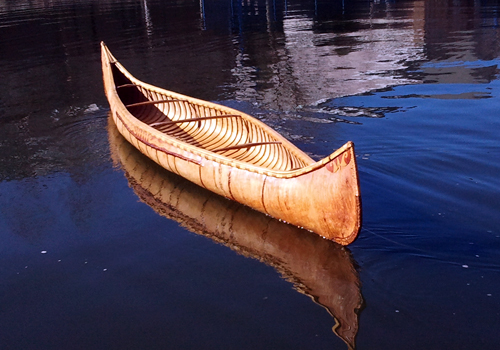Birch, that is.
I love birches for three reasons:
- If you’re cutting firewood, birch logs split if you so much as spit on them. Wave an ax in their general direction and they fall over in two and cry uncle.
- The wood makes great plywood if you’re building cabinets or bookshelves. Stable, light and strong.
- Birch bark is gorgeous. Pliable. And most of all waterproof.
Because of birch bark, one can make birch bark canoes.
Though canoes have been made for who knows how many hundreds of years, the guy who make it all possible for the skill to be kept alive was a gentleman named Tappan Adney. Adney almost single-handedly rescued the bark canoe from oblivion. With other materials available, native builders gradually turned to canoes that required less care and feeding. So while native peoples across the northern US and Canada embraced aluminum, the old guys who built bark canoes were slowly dying off. With Adney’s careful surveys and measurements, along with the over 100 models of different types of canoes, the older folks were able to recall their memories and teach younger people how to build a canoe.
Now a few dozen builders keep the eternal flame burning
This particular canoe is a 16-foot Abenaki Algonquin built by a fine artist and craftsman, Aaron York. I commissioned it in 2003 and the original intent was to sell it and make a small profit (yes, really small). At $500 a lineal foot, a 16-foot canoe would go for about $8,000.
Lest you think that ridiculous, let me tell you that in twenty years it’ll be worth triple that. There’s a simple reason: supply and demand. There are almost no more birch that are of sufficient size to build canoes like this. This canoe came from a single sheet of bark, which is almost unheard of these days. Aaron harvested this particular tree in northern Quebec. He won’t tell anyone where. I wouldn’t either.
After I took delivery of this boat I called Aaron to tell him how astoundingly beautiful it was. He laughed and said that he would never build another like that, and that he knew when I saw it I would want to keep it for myself. When I saw the detail, believe me, I was tempted. It is a stunning boat. Aaron put care into this one, probably one of his best.
The dark brown insert is a piece of winter bark. During the winter the bark develops a layer of cambium that is darker, so it allows the artist/builder to do some artwork by scraping away the darker layer to create designs. This is not painted so much as etched. Using fine tools, Aaron scraped until he created this panel of the Algonquin deity of Lake Champlain. Padasoks (spelling varies) stirs up the lake with his tail and creates storms when the lake is not respected.
This was a ton of work. This deserves its own paragraph.
This canoe ( have named her Wanakiwide`e, which means peaceful heart in our local native dialect, Ojibway) has been hanging up in the shop for a few years. Pretty, but unhappy, Waanakiwide’e needed some TLC. With some pitch obtained from Ferdy Goode, another great bark builder, I took her down and loved her up. I pitched the seams that were cracked and put her in the water. A few seeps, but I’ll go over her again tonight and she’ll be as tight as a drum.
She’s alive again. I may still sell her, but it’s gonna have to be to the right person. I will not let her hang in someone’s “lake house” up north, high over the fireplace in a cathedral ceiling. She is alive again, and will remain so.
Respectfully submitted,
Canoelover
P.S. If a lake house is more than 4,000 square feet, it’s not a lake house. It’s a mansion.






I went to college with Aaron as a Biology major…. this seems a much better fit as it was his passion. Gorgeous.